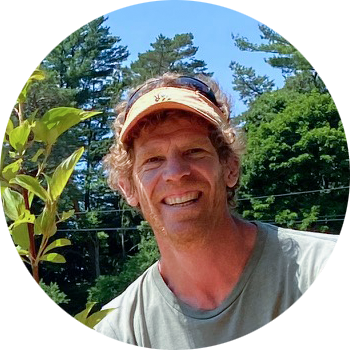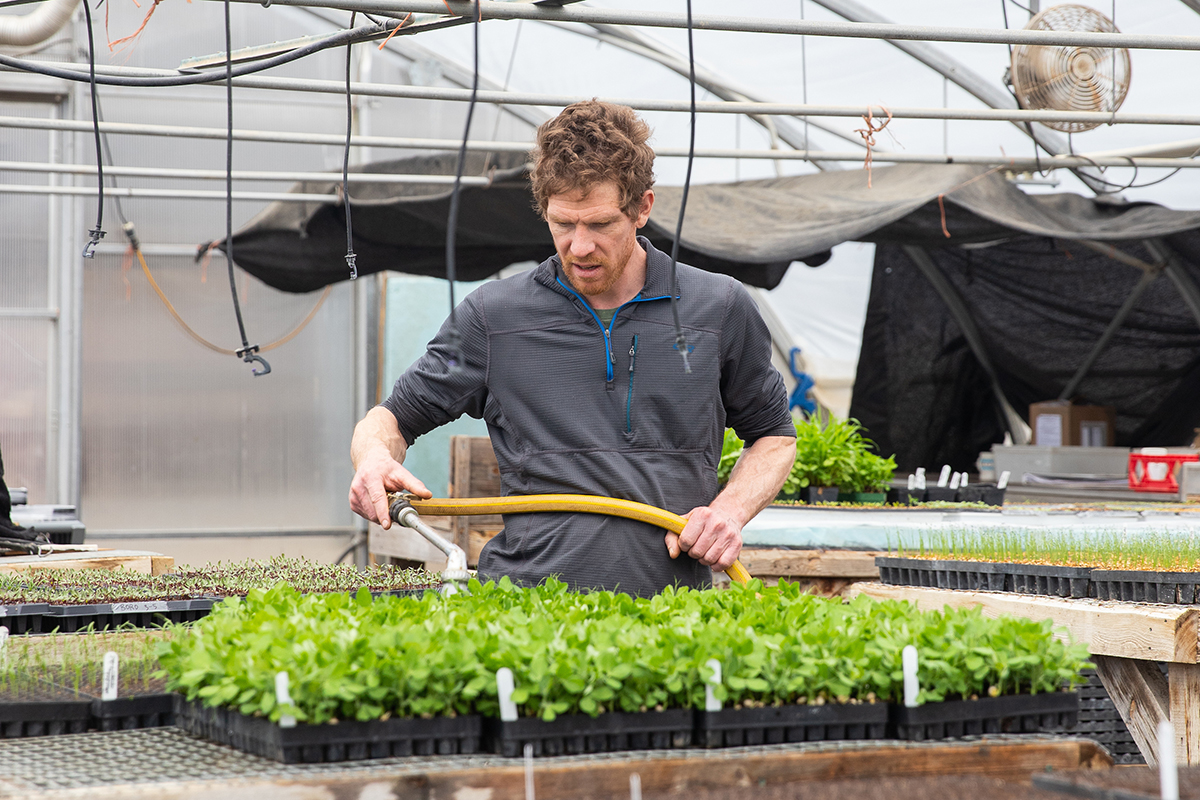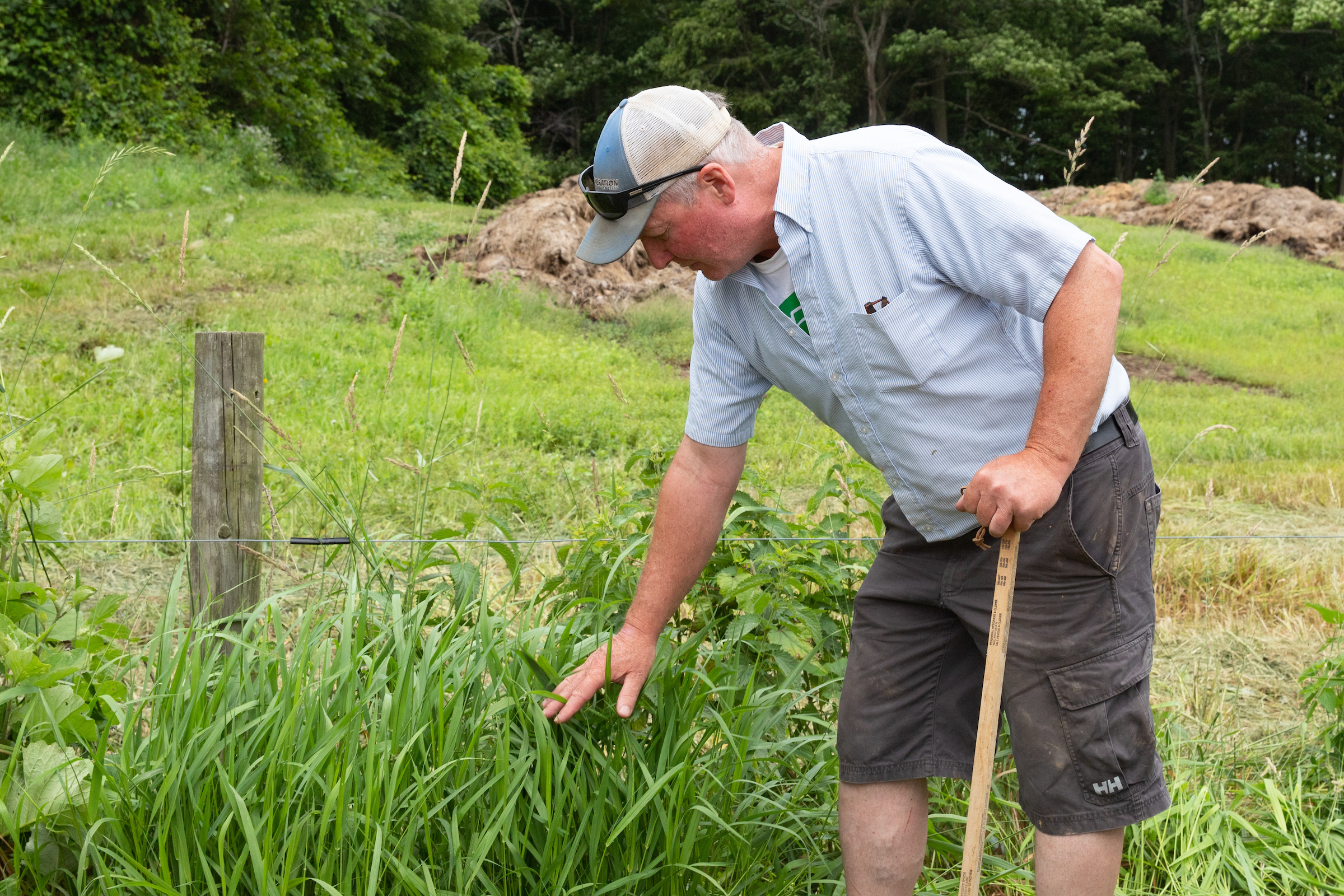Excellent explanations of climate-driven decision making.
Adapting to changing weather
"How are you responding to the more unpredictable weather patterns brought on by climate change?"
We asked each of our land managers this question. Here are their answers.
 Josh Carter, Market Gardener
Josh Carter, Market Gardener
"When growing vegetables, fruits, and flowers outside, you are at the will of mother nature, but we are adapting to less predictable weather patterns in three major ways:
- Improving our soil health and resilience
- Growing more crops under the protection of tunnels (unheated hoop structure with plastic cover)
- Growing a diversity of crops over the entire season
To improve soil health, we till less often and less destructively (more shallow); we seed cover crops (winter rye, hairy vetch, clover, ryegrass, buckwheat, oats, peas) when we are not growing cash crops (veggies) to keep the soil alive; we cover soil with silage tarps when we can't grow anything; we rotate crops and fields so pests and diseases don't build up; and we add farm-made compost to improve the soil’s fertility, biology, and structure.

Inside high tunnels, we have more control of the climate. It is easier to keep the plants warm and dry, and the soil watered and fertile. Tunnels also lengthen the season so we can start growing crops earlier, keep them growing later into the fall, and keep plants alive in the winter. Tunnels do pose their own problems: they can get too hot, and pests and diseases can build up, but we can manage for this.
We grow over 50 different types of vegetables during the season and sow multiple successions of many crops (like beets, carrots, lettuce, kale, cucumbers, zucchini, beans). This gives us better odds of being successful when the climate does not provide the best growing conditions. If one crop does not do well–like seeding carrots before a hot dry spell in July, another crop may be thriving under these conditions (e.g. tomatoes, watermelons).
 Sam Dixon, Dairy Manager
Sam Dixon, Dairy Manager
"Two or three years ago, I changed my thinking about how I was going to do my job. We were used to scheduling work based on seasonal patterns or traditions, and I realized that that wasn't doable anymore. Things were too unpredictable. Instead, we just have to do things when we can do them, looking no more than a couple months out.
The 2023 season was a great example of that. The first cut of hay used to happen around Memorial Day. But all our equipment was ready to go on May 11 and the grass was ready to go, too. So we said, “Let's go!” And we went out and made 1,300 bales of really nice hay by the first of June, before it started raining. Every farmer who waited got caught and couldn't make hay.

Another example from 2023: Normally, you don't spread a lot of manure in April. You wait until after the first cut. But in 2023, April was really dry, and the ground was ready to go. So I got our custom operators to spread a third of the manure that we normally spread throughout the whole year. And I was so glad I did that because the summer was so wet. If we had waited, the manure pits would have been over full and we wouldn't have been able to get on the land. We would have had a problem.
We also need to be flexible in how we manage the dairy cows, based on the conditions. Several times this past summer, we kept the cows in for three or four days because the pastures were so wet. And when it’s really hot, we bring the cows into the barn during the day and put fans on them to keep them cool, and turn them out at night.
One final part of climate uncertainty is that we have been utilizing a lot more land than a farm our size would necessarily need. We’re fortunate that way–we have the land–and it gives us a cushion to bail up extra grass in a dry year.
Basically, we have to be thinking ahead, watching the weather, and be ready to respond quickly when conditions are right. We can’t put anything off because you don't know what's going to happen next. No more counting on seasonal patterns. When you can do things, you have to go out and get them done.
 Dana Bishop, Woodlands Manager
Dana Bishop, Woodlands Manager
On some level, a lot of our trees are resilient to various weather events because they're native. They’ve been here for a long time and they've been through it. They are probably a bit more hardy than a garden crop. If there’s a drought, say, I feel like the trees are resilient enough to deal with it. (And I can't water the whole forest!). But when you start layering on multiple stresses, like drought coupled with disease, the trees are definitely going to take a hit. That's going to be harder to manage.
And that's where we need to start being really mindful of having that next generation of healthy trees ready to take over. But it's not always clear what the next generation is going to be here. A lot of our forest stands are very mature and have a closed canopy, so there’s not much sunlight on the forest floor. That means there’s not much of an understory of pole-sized oaks and hickories that are ready to take over.
But at the same time, when we’re marking trees for harvest in the forest stands, we think about how we can favor the more climate adaptive species, like the oaks and hickories. So we might cut some trees away from these species to give them more space to grow. And in the new Marshall Woods area, we're planting trees that are more climate adapted.
As for sugaring, right now we just need to be ready to tap early. This year we had our taps in by early January and we could probably have tapped even earlier and gotten earlier sap runs. But then again, if you tap really early, the tap holes will start closing in like six to eight weeks, so you’ll get less sap flow later in the season. And that early schedule also means we have to rethink the seasonality of our jobs. Because typically we are cutting firewood and doing stand work in December or January, not sugaring. My job kind of marches with the seasons, and as those seasons are changing, we haven't quite changed our march yet. But I feel like it will become clearer. And right now we’re in a good groove.